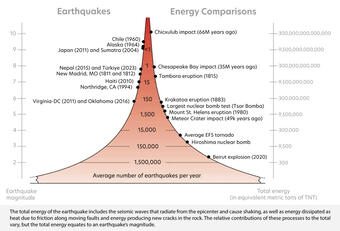Can a nuclear blast trigger a Yellowstone eruption? No. But how about an earthquake? Also no.
YVO has noted, with some amusement, tabloid headlines about various diabolical schemes to trigger an eruption of Yellowstone by nuking the caldera. If you find these crazy schemes somewhat unnerving, please don't be concerned—such a plan has zero chance of working!
You see, unlike science fiction stories, in which nuclear weapons seem to be the cause of, and solution to, many geological catastrophes, science fact tells us that you aren't likely to trigger a Yellowstone cataclysm with a nuclear weapon. How do we know? It's because this experiment has already been tried.
Earthquakes release a tremendous amount of energy, which can be expressed in terms of the equivalent size of explosive. For example, the strongest earthquakes ever recorded, which are above magnitude 9 (like the 2011 Tohoku, Japan, earthquake), release the energy of nearly a 2000-megaton nuclear weapon. For reference, the strongest nuclear test ever was a 50-megaton explosion conducted by the Soviet Union in 1961.
The Yellowstone region is not immune to large earthquakes, as most readers know. For instance, in 1975 a M6.1 quake struck the area near Norris Geyser Basin. The largest earthquake recorded in the region is the M7.3 Hebgen Lake earthquake, which occurred on the western boundary of the park at a depth of about 10 km (6 mi).
The Hebgen Lake earthquake released more energy than a 2-megaton nuclear weapon—100 times larger than the atomic bomb that destroyed Hiroshima in 1945, and equivalent to an "average" hydrogen bomb. What's more, this earthquake occurred not above, but next to Yellowstone's largely solid magma body, so most of the earthquake's energy was transmitted directly into the rock. In a nuclear attack, the detonation would occur above ground, so the majority of the energy would be released into the air. And guess what happened to Yellowstone volcano after the M7.3 earthquake? It didn't erupt! The only impacts were some changes in hot springs and geysers due to the shaking.
1959 was not the first time an earthquake occurred on the Hebgen Lake fault. Studies of the geology of the region indicate that there have been at least three strong earthquakes on the fault in the past 15,000 years. This implies a recurrence interval on the order of one strong earthquake per several thousand years. That means since Yellowstone's last magmatic eruption 70,000 years ago (a lava flow, not a major explosion), there might have been a dozen or more earthquakes equivalent to a moderate thermonuclear explosion next to the Yellowstone magma storage region. None triggered an eruption. Since the last caldera-forming explosion 631,000 years ago there might have been hundreds of such earthquakes!
The same holds true when considering large earthquakes on the Pacific-North America plate boundary, like an M8 on the San Andreas Fault or a potential M9 in the Pacific Northwest. The San Andreas might experience a M8 event every 200 years or so, meaning that there could have been 350 such events since the last Yellowstone lava flow and over 3,000 such events since the last huge explosion. Pacific Northwest M9 earthquakes seem to occur, on average, about every 500 years, meaning that there might have been about 140 such events since the last Yellowstone lava flow and over 1200 since the last huge explosion. Clearly, these events do not commonly trigger Yellowstone eruptions.
Thus, it would seem we have little to worry about in terms of Yellowstone being "set off" by some external trigger, be it a distant massive earthquake, a local strong earthquake, or a very local nuclear blast. That isn't to say that there wouldn't be some noticeable effects, however. Distant earthquakes have triggered clusters of small earthquakes at Yellowstone (like those caused by the 2002 Denali, Alaska, earthquake), and variations in geyser eruption patterns are a common consequence of local and distant strong earthquakes. Seismic shaking can cause hydrothermal plumbing systems to collapse, changing how Yellowstone thermal features behave and even resulting in small steam explosions.
But triggering an eruption of magma from Yellowstone is not easy—no eruptions have happened in the past 70,000 years despite numerous strong earthquakes in the region. An eruption will occur only when there is a quantity of liquid magma in the subsurface and sufficient pressure to get that magma to ascend to the surface. Neither condition is currently in place. As a matter of fact, there's only 5-15% liquid in the mostly crystalline magma storage region. So, no matter what the tabloids dream up, the threat of a Yellowstone eruption remains low.



